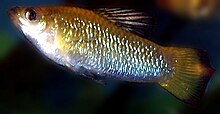Лимия Перуги
| Лимия Перуги | |
|---|---|

| |
| Плохой | |

| |
| Женщина | |
| Scientific classification | |
| Domain: | Eukaryota |
| Kingdom: | Animalia |
| Phylum: | Chordata |
| Class: | Actinopterygii |
| Order: | Cyprinodontiformes |
| Family: | Poeciliidae |
| Genus: | Limia |
| Species: | L. perugiae
|
| Binomial name | |
| Limia perugiae (Evermann & H. W. Clark, 1906)
| |
| Synonyms[2] | |
| |
Лимия Перуджи ( Лимия Перудж ) - это поэцилидская рыба , эндемичная для Карибского острова Эспаньола . Это один из самых распространенных видов в роде Лимии , обитающих водах от свежих до гиперзалии . В отличие от большинства видов Limia , perugiae всеядна L. . Доминирующие мужчины особенно красочные. Женщины рожают живой молодой.
Таксономия
[ редактировать ]L. perugiae был описан как Platypoecilus perugiae в 1906 году Бартоном Уорреном Эверманом и Говардом Уолтоном Кларком с типовым местом, предоставленным как небольшой поток в горах Сан -Франциско Доминиканской Республики. [ 3 ] Конкретное название чествует итальянский ихтиолог Альберто Перуджи (1847–1897) Гражданского музея естественной истории Генуи в знак признания его работы над западно -индийскими рыбами. [ 4 ]
Описание
[ редактировать ]L. perugiae populations inhabiting the hypersaline localities of Lago Enriquillo, Laguna de Oviedo, and Las Salinas are smaller and less colorful and have proportionally larger heads than those living in the nearby freshwater habitats. Freshwater males develop more distinct secondary sex characteristics, including a broader body and longer fins. The males from hypersaline populations have narrower bodies and a more juvenile appearance.[5]
L. perugiae males are polymorphic for size, ranging in adulthood from 20 mm to 60 mm, and may be classified as large, intermediate, and small. The females show no such variation and average about 40 mm in adulthood. The cessation of growth is brought on by the onset of sexual maturity, which is in turn genetically determined but also influenced by environmental factors.[6] In dominant males, the blue hues of the body are contrasted by the yellow caudal fin with a black margin and the black dorsal fin. The intensity of the coloration increases with the male's rank.[6]
Distribution and habitat
[edit]L. perugiae is endemic to the southeast of the island of Hispaniola in the Caribbean.[6] It is the most widely distributed Limia species on the island[6] and one of the most successful and broadly distributed Limia species altogether.[5] It inhabits freshwater systems as well as saline and hypersaline lakes and coastal lagoons;[5] and clear springs as well as polluted man-made ditches and muddy creeks.[6]
Diet
[edit]While Limia species tend to feed primarily or exclusively on detritus and algae, particularly widespread species such as L. perugiae and L. zonata have more generalized, omnivorous feeding habits. L. perugiae has been found to take a moderate amount of terrestrial and aquatic invertebrates. The species expands its dietary niche in the wet season. It has the large gut length that is most commonly associated with the more herbivorous species, however, which suggests that it may adapt its diet to the various types of environments it inhabits.[7]
Reproduction
[edit]
There tends to be the same number of males and females in a L. perugiae population. Males are not territorial. Large, dominant males spend most of their time competing with other males and courting females, whereas smaller males attempt to mate more often and exhibit a simpler sneaking behavior instead. Females do not discern between courting and non-courting males when choosing a mate. Instead, they have been observed to choose exclusively by body size, preferring larger males to smaller.[6]
In smaller populations the larger males have greater reproductive success than the intermediate and small males. This success has been attributed by Schartl et al. to the larger males' dominance and courtship behavior. In larger populations, however, the large males fail to reproduce altogether, and it is the intermediate males who are the most successful at mating. Schartl et al. believe this to be due to dominant males in large populations spending time fighting amongst themselves and less time attempting to mate, allowing the subordinate males to pursue females freely.[6]
L. perugiae is a livebearer. Like other livebearers, this species provides no parental care. It produces a large number of offspring, most of which fall prey to predators; only few survive to adulthood.[6]
References
[edit]- ^ Lyons, T.J.; Rodríguez-Silva, R. (2021). "Limia perugiae". IUCN Red List of Threatened Species. 2021: e.T125981311A125986628. doi:10.2305/IUCN.UK.2021-1.RLTS.T125981311A125986628.en. Retrieved 18 November 2021.
- ^ Froese, Rainer; Pauly, Daniel (eds.). "Limia perugiae". FishBase. August 2019 version.
- ^ Eschmeyer, William N.; Fricke, Ron & van der Laan, Richard (eds.). "Platypoecilus perugiae". Catalog of Fishes. California Academy of Sciences. Retrieved 6 November 2019.
- ^ Christopher Scharpf; Kenneth J. Lazara (26 October 2019). "Order CYPRINODONTIFORMES: Families POECILIIDAE, ANABLEPIDAE, VALENCIIDAE, APHANIIDAE and PROCATOPODIDAE". The ETYFish Project Fish Name Etymology Database. Christopher Scharpf and Kenneth J. Lazara. Retrieved 6 November 2019.
- ^ Jump up to: a b c Weaver, Pablo F.; Tello, Oscar; Krieger, Jonathan; Marmolejo, Arlen; Weaver, Kathleen F.; Garcia, Jerome V.; Cruz, Alexander (2016). "Hypersalinity drives physiological and morphological changes in Limia perugiae (Poeciliidae)". Biology Open. 5 (8): 1093–1101. doi:10.1242/bio.017277. PMC 5004605. PMID 27402966. Retrieved 4 August 2024.
- ^ Jump up to: a b c d e f g h Schartl, Manfred; Erbelding-Denkt, Claudia; Holter, Sabine; Nanda, Indrajit; Schmid, Michael; Schrodert, Johannes Horst; Epplen, Jörg T. (August 1993). "Reproductive failure of dominant males in the poeciliid fish Limia perugiae determined by DNA fingerprinting". Proceedings of the National Academy of Sciences of the United States of America. 90 (15): 7064–7068. Bibcode:1993PNAS...90.7064S. doi:10.1073/pnas.90.15.7064. JSTOR 2362652. PMC 47076. PMID 8346218.
- ^ Rodriguez-Silva, Rodet; Spikes, Montrai; Iturriaga, Manuel; Bennett, Kerri-Ann; Josaphat, James; Torres-Pineda, Patricia; Bräger, Stefan; Schlupp, Ingo (11 October 2021). "Feeding strategies and diet variation in livebearing fishes of the genus Limia (Cyprinodontiformes: Poeciliidae) in the Greater Antilles". Ecology of Freshwater Fish. 31 (2): 389–400. doi:10.1111/eff.12638. S2CID 244612970. Retrieved 22 September 2023.
